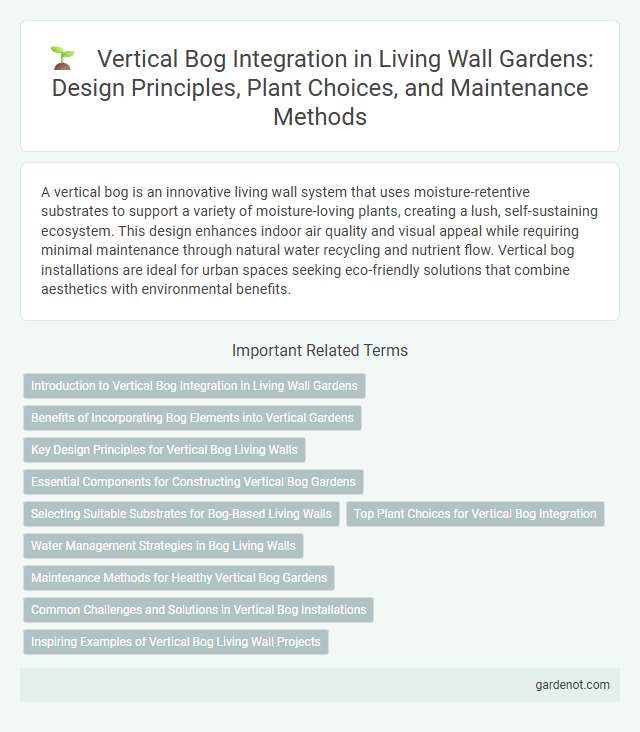A vertical bog is an innovative living wall system that uses moisture-retentive substrates to support a variety of moisture-loving plants, creating a lush, self-sustaining ecosystem. This design enhances indoor air quality and visual appeal while requiring minimal maintenance through natural water recycling and nutrient flow. Vertical bog installations are ideal for urban spaces seeking eco-friendly solutions that combine aesthetics with environmental benefits.
Introduction to Vertical Bog Integration in Living Wall Gardens
Vertical bog systems enhance living wall gardens by combining hydroponic techniques with natural bog plants, creating a self-sustaining ecosystem. This integration supports moisture retention and nutrient cycling, promoting robust plant growth and biodiversity. Incorporating vertical bogs improves air quality and insulation, making living walls more efficient and environmentally beneficial.
Benefits of Incorporating Bog Elements into Vertical Gardens
Incorporating vertical bog elements into living walls enhances moisture retention and supports diverse plant species by mimicking natural wetland conditions. Vertical bogs improve air quality and create microhabitats that attract beneficial insects and pollinators, boosting urban biodiversity. These green installations also regulate indoor temperature and reduce noise pollution, contributing to sustainable building design.
Key Design Principles for Vertical Bog Living Walls
Key design principles for vertical bog living walls emphasize maintaining a balanced hydrological cycle by integrating consistent moisture retention through layers of absorbent substrates like sphagnum moss and engineered soil mixes. Structural support must accommodate weight fluctuations caused by water saturation, ensuring vertical stability with durable frameworks and proper anchoring. Additionally, plant selection prioritizes bog-adapted species with high water and nutrient uptake efficiency, enhancing filtration and biodiversity within the vertical garden system.
Essential Components for Constructing Vertical Bog Gardens
Constructing a vertical bog garden requires essential components such as a waterproof backing to protect structures from moisture damage, a durable frame to support the weight of saturated plants and substrate, and a specialized growing medium that retains moisture while providing adequate aeration. Incorporating moisture-loving bog plants like sedges, ferns, and carnivorous species ensures optimal growth within the saturated environment. Efficient irrigation systems and proper drainage layers are critical to maintaining consistent hydration without waterlogging the root zone.
Selecting Suitable Substrates for Bog-Based Living Walls
Vertical bog living walls require substrates with excellent water retention and aeration properties to support wetland plant species. Sphagnum peat, coir fiber, and specialized compost blends offer optimal moisture balance while preventing root rot in bog environments. Choosing substrates rich in organic matter enhances nutrient availability, ensuring healthy growth in vertical bog systems.
Top Plant Choices for Vertical Bog Integration
Sphagnum moss, cranberry plants, and Carex species are top choices for vertical bog integration due to their natural moisture retention and adaptability to saturated environments. These plants thrive in high humidity and acidic substrates typical of vertical bogs, promoting a balanced ecosystem and improving air quality. Incorporating native wetland species like bog rosemary and sundews can further enhance biodiversity and aesthetic appeal in living wall designs.
Water Management Strategies in Bog Living Walls
Vertical bog living walls employ advanced water management strategies to optimize moisture retention and reduce runoff. These systems utilize layered substrates and capillary mats to maintain consistent hydration levels while preventing waterlogging. Incorporating recirculation technology and sensor-driven irrigation ensures precise water delivery, enhancing plant health and sustainability.
Maintenance Methods for Healthy Vertical Bog Gardens
Vertical bog gardens require consistent moisture monitoring to maintain optimal hydration levels for plant roots, preventing both drying out and waterlogging. Regular pruning and removal of dead foliage help sustain plant health and encourage new growth within the vertical structure. Implementing integrated pest management and periodically checking irrigation systems ensure a robust and thriving vertical bog garden environment.
Common Challenges and Solutions in Vertical Bog Installations
Vertical bog installations often face challenges such as waterlogging, root rot, and inadequate drainage systems that can compromise plant health. Implementing engineered drainage layers and selecting hydrophilic yet well-structured substrates help manage moisture levels effectively. Regular monitoring for nutrient imbalance and incorporating automatic irrigation systems optimize plant vitality and long-term sustainability.
Inspiring Examples of Vertical Bog Living Wall Projects
Vertical bog living wall projects, such as the New York High Line and Singapore's Changi Airport, showcase innovative integration of native wetland plants that enhance urban biodiversity and improve air quality. These installations rely on specialized water retention systems that mimic natural bog conditions, supporting diverse flora while reducing surface runoff. By incorporating sustainable design principles, vertical bogs offer scalable solutions for green infrastructure in densely populated cities.
Vertical bog Infographic

 gardenot.com
gardenot.com